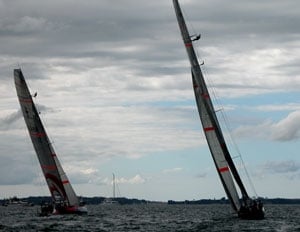
In nine days, the Royal New Zealand Yacht Squadron race committee has only run three races of this America’s Cup. Weather delays are a normal part of sailboat racing. But this race committee, under the direction of Principal Race Officer Harold Bennett is overly patient. The Swiss challenger, Alinghi, seems ready to go. While Alinghi is out tuning up, Team New Zealand sits with a tarp, shielding the crew from the sun. It is clear that TNZ is not anxious to race in unsettled or light winds. By our calculations, the wind shifted 50 degrees throughout the afternoon today. These are not big wind shifts for this body of water. A proactive RC would’ve worked harder to get a race underway. One of the purposes of having a best-of-nine series is to test the sailors in a variety of conditions. A light, shifty race is every bit as interesting as a steady wind race. Ironically, TNZ seemed to be very competitive against Alinghi in the light winds of race two. So it’s curious why they resist wanting to sail. Bennett frequently communicated with the boats. He wears a microphone and gives interviews to the media. In his commentary, he always sounds pessimistic. What he should do is take the average wind direction, put the buoys down and get the race underway. The sailing instructions allow for a 45-minute time limit for each leg. If the wind dies, the time limit will run out. If the wind shifts, the race committee has the option of changing the course of the next leg to keep the legs square to the wind. These problems have plagued sailing in the past. In 1896, during the first modern Olympic Games in Athens, Greece, the race committee was unable to complete a race in two weeks of trying. Even in the 2000 America’s Cup, it took twelve days to get the five races completed. At the present rate, we could be here for two more weeks. The challenger trials for the Louis Vuitton Cup lost 19 days of racing. The problem was a self-imposed wind limit of 7 to 19 mph. There is no upper or lower wind limit for the America’s Cup. So why not race? It would be no problem if Alinghi and Team New Zealand were sailing by themselves. However, with the huge commitment to worldwide television, many thousands of spectators who have travelled great distances to be here and even the sailors themselves, the RNZYS would serve their regatta and the sport of sailing better, by working harder to get the races in, even though the wind is not perfect. The competitors have agreed to race on Monday (local time), a scheduled day off. The wind is forecasted for 15 mph out the east. Everyone here in Auckland is hoping to see some action for the first time in nearly a week.









